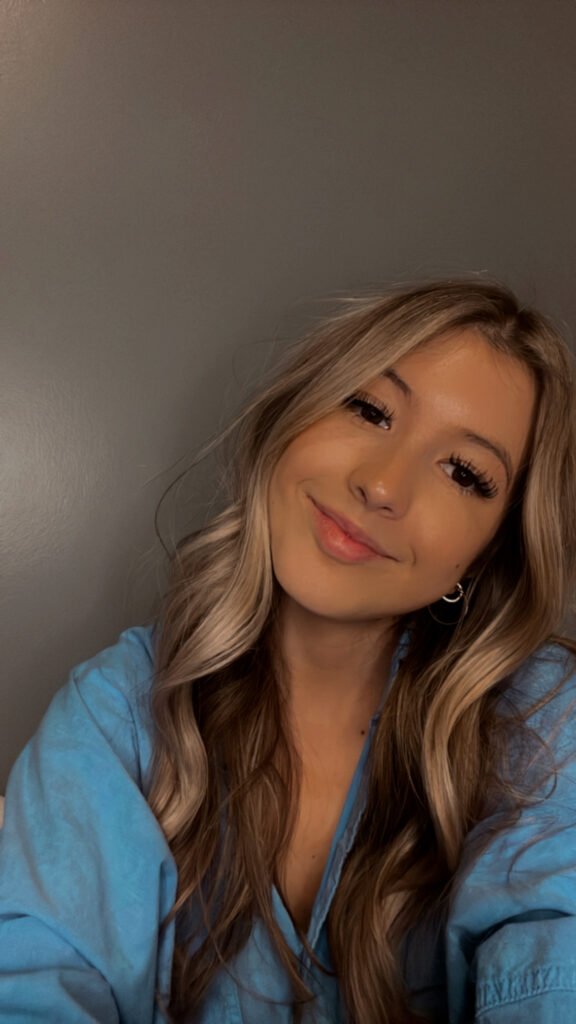Category: Learning Project
My Piano Learning Journey Has Come To An End..
This semester flew by–and so did my piano learning project. As part of my EDTC 300 course, I was tasked with choosing a skill to learn using online tools and documenting my journey through weekly blog posts.
For my learning journey, I decided to learn how to play the piano–a goal I’ve always had in the back of my mind, but never really fully committed to. My piano keyboard was sitting in the back of my closet collecting dust, and I thought it was the perfect time to put it to use. I had zero formal training, and while I knew a few basic notes, such as the Major C in the center of the keyboard. I started from scratch when it came to technique, rhythm, and music coordination. I also wanted to explore how accessible learning a new musical instrument could be using digital resources–no private lessons, no books, just me, the keyboard, and the internet.
So how did my piano learning journey go? Was it everything I thought it would be? Not exactly. Was it full of trial, error, restarts, and stumps? Definitely. Some weeks felt incredibly rewarding, with awesome various resources, and others made me want to throw my keyboard away. As I could find little to no resources to some, and they were significantly challenging to learn. But through it all, I saw real progress. I learned a ton about persistence, and discovered just how powerful online learning can be.
Here’s a quick recap of my piano learning journey:
- Week 1: Introduction to my Piano Learning Journey!
- I introduced my learning project of choosing to learn the piano.
- My love for piano began as a child, inspired by watching my neighbour play a beautiful old piano filled with history and music.
- Now, as a future teacher, I’m using this learning project to reconnect with that passion and explore how music can support well-being and creativity in the classroom.
- My goal is to learn the basics and play a simple song by the end of the semester, starting with apps like Simply Piano and Skoove and sharing my progress along the way.
- Week 2: Meeting the Keys!
- This week, I focused on the piano fundamentals: identifying white key names, finding Middle C, learning finger positions, and trying out a simple 4-note rhythm.
- I used Flowkey to improve posture and hand placement, and Simply Piano to begin reading notes and even play my first beginner song, Say Something.
- Week 3: Cracking the Code!
- Focused on reading notes on the grand staff, including treble and bass clef, and identifying Middle C as my starting point.
- Used Pianote to learn the basics of reading lines, spaces, and ledger lines, with helpful memory tricks like “Every Good Boy Deserves Fudge” and “FACE.”
- Practiced with NoteVision, an interactive app that gave real-time feedback and helped me match staff notes to the correct piano keys.
- This week made reading music feel less overwhelming and gave me a strong foundation to build on for future songs!
- Week 4: Counting the Beat
- Focused on learning note values (whole, half, quarter, eighth, sixteenth) and how long to hold each when playing, using the Music4Kids YouTube channel.
- Practiced identifying note parts (head, stem, flag) and how they relate to beat counts in 4/4 time signature.
- Used Pinterest to find beginner sheet music (Mary Had a Little Lamb) and practiced drawing each note on a music staff.
- Gained a deeper understanding of rhythm as the heartbeat of music, and started connecting note shapes to sound duration—next week’s goal: time signatures + clapping with a metronome!
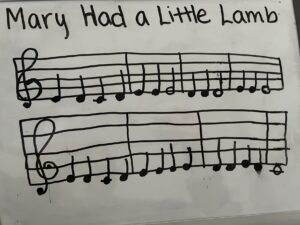
- Week 5: Clap. Count. Play.
- Learned how to read time signatures (like 4/4, 3/4, 6/8) using “Crack the Code” and practiced clapping them out using metronome tools and the “Rhythm Clap Along” YouTube video.
- Discovered how time signatures affect the feel of music (e.g., 3/4 for waltzes, 6/8 for jigs, 5/4 for jazz), making rhythm more understandable and musical,
- Practiced clapping rhythms with an online metronome, starting with quarter notes and building to eighth notes—challenging but helped me internalize steady beats.
- Gained confidence by feeling rhythm in my body, not just counting, and found rhythm clapping to be a powerful step before playing actual music!
- Week 6: Unlocking my Inner Jukebox
- Focused on pitch recognition through daily ear training using beginner-friendly apps and YouTube games (C&G, C&E) to match notes like C, E, and G by sound.
- Practiced identifying chords by ear using a virtual keyboard and my own piano for reference—challenging but rewarding with daily 10–15 minute sessions.
- Learned that ear training builds gradually through repetition and failure, helping me begin to “feel” notes rather than just memorize them.
- Found kid-friendly tools especially helpful and accessible, though noted a lack of strong digital ear training resources, making this one of my toughest weeks yet.
- Week 7: My Piano Journey has come to an end..
- I wanted to end this project with a piece that meant something to me. I chose “Hallelujah” by Leonard Cohen—a song that has always made me feel something deep and indescribable. Learning it felt like a full-circle moment. It challenged me with its pace, arpeggios, and transitions, but also reminded me why music is so powerful.
- Summing up my Learning Journey
Here’s the final video of me playing Hallelujah
(Played off the sheet music from musescore and Youtube channel Betacustic)
Reflections on Learning Online
What did learning online make possible?
- Unlimited Access to Resources Anytime, Anywhere
-
- Learning online gave me countless 24/7 access to tutorials, interactive tools, and beginner sheet music. Whether I was practicing at home, watching videos on the go, or reading articles on study breaks, I always found something new to support my online learning. At times, it was challenging to find the correct resources that worked best for me. In the end, I found my way through resources I had.

2. Learning from random experts
-
- YouTube teachers like Piano Lessons on Pianote made complicated ideas feel simple and engaging. Their step-by-step tutorials and visual tools helped me understand everything from hand positioning to note values to playing full songs. It felt like having a personal teacher in my room.
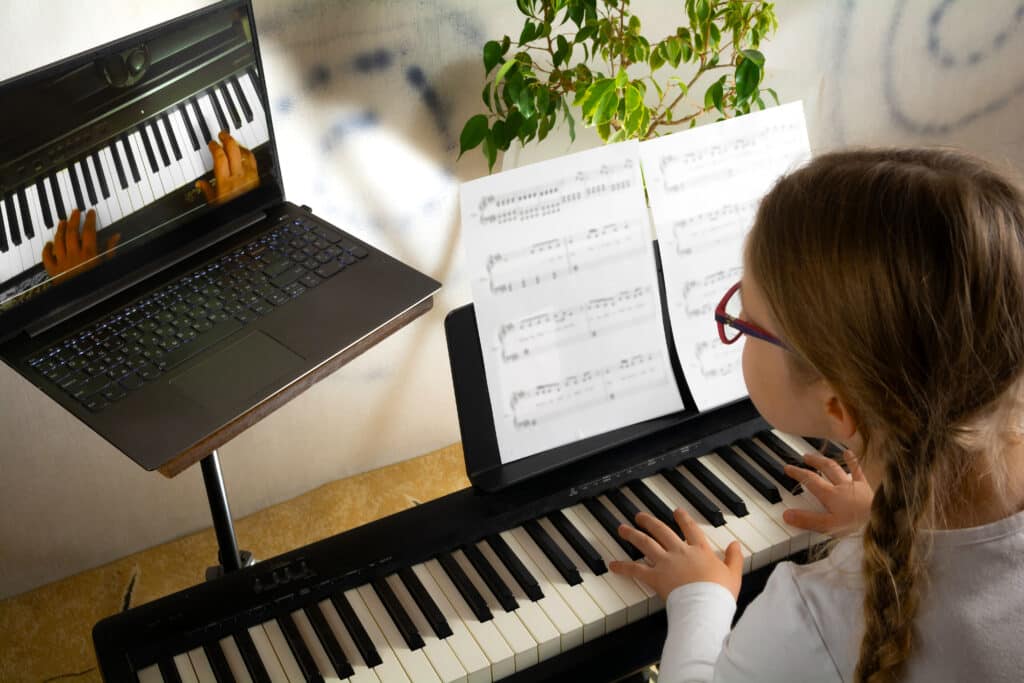
3. Control over my own Pace
-
- One of the biggest benefits was the ability to pause, rewind, or rewatch lessons as often as I needed. If I missed something or felt confused, I didn’t have to wait for help—I could replay that section until it clicked. This flexibility made learning less stressful and more supportive of my pace. Especially when it came to the pace of when I learned and when I felt like it was time to move on. In normal classes with a teacher, I wouldn’t have the chance to learn lessons on my own time and practice over and over again until I learned the next lesson. It helped my anxiety tremendously.
4. Opportunities to Share, Reflect, and Connect
-
-
Documenting my progress weekly allowed me to reflect on what I was learning and where I was growing. Sharing videos, reflections, and challenges through blog posts connected me to others and gave me encouraging feedback that helped keep me going. It felt like being part of a learning community.
-

What was difficult about learning online?
- Lack of Real-Time Feedback
-
- Without a live teacher watching me play, it was easy to miss mistakes—especially with posture, hand position, or subtle rhythm errors. Sometimes I didn’t even realize I was doing something wrong until I rewatched my own videos or stumbled in a lesson later on.
- I did have my peers feedback to reflect on my learning journey. However, not all of my posts got commented on. If they did, it was never in the moment. Typically almost a week later. It was up to me to decide if my mistakes were caught or if I was even doing something particular correct.
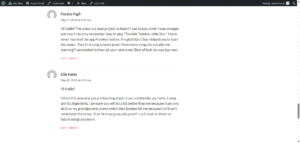
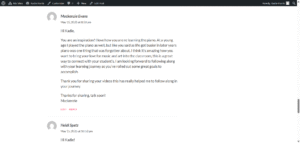
2. Lack of Structure and Direction
-
- With so many resources available, it was sometimes overwhelming to know what to focus on next. I had to build my own learning path, which meant constantly deciding what I should be practicing, what skill to build, or when to move on. That flexibility was great—but also a challenge.
3. Balancing Practice with Documentation
-
- I noticed that a significant amount of time went into preparing my blog posts—writing reflections, recording videos, organizing thoughts, and editing content. While this was meaningful and helped me learn, it sometimes cut into the time I could have spent actually practicing on the piano.
Final Thoughts
This project stretched me in unexpected ways. I thought I’d just be learning a few notes and calling it a day, but I ended up developing a whole new appreciation for what it takes to stick with something hard, especially when no one is making you do it.
One of my biggest takeaways? The importance of celebrating progress over perfection. There were moments where I was frustrated, slow, and full of self-doubt. But there were also breakthroughs, joy, and a sense of peace in seeing improvement over time.
When I have my own classroom, I want to give students the space to try, struggle, reflect, and grow—just like I did through this project. I’ll definitely be encouraging them to try learning something online, document their process, and be proud of how far they come.
Thank you to everyone who followed along on this journey. Now, if you’ll excuse me, I’ve got a few more songs to learn…
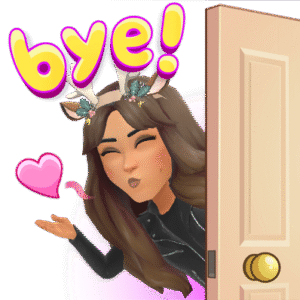
This week, I dove into ear training for this week’s learning journey of learning the piano. It turned out to be one of the most humbling parts of learning the piano so far. Unlike past weeks where I focused on technique, or learning songs, this week was all about listening–really listening–and building the ability to recognize pitch, intervals, and chords by ear.
Online Tools I Used
- Ear training (APP) – listening chords and finding notes on keyboards
- Ear training for kids C&G – fun pitch matching game
- Ear training for kids C&E – fun pitch matching game
What is Ear Training? Why is it Important in Music?
Ear training is the practice of teaching your ears to recognize musical elements like pitch, intervals, chords, and rhythm. This week, I focused on pitch recognition, which is the ability to name a note (like C, E, or G) just by hearing it.
Through my digital videos and apps, I learned to listen closely to small differences in sounds. I learned that:
- C sounds like a strong, grounded note–it often feels like “home base.”
- E is higher, a bit brighter
- G has a rounder, warmer tone that’s deeper than E
Practicing
First I practiced starting each session this week with the C & G and C & E youtube videos. These were simple, but very effective. They played a note, and I had to match it to the correct pitch. The repetition and friendly tone made it easier to focus, and the feedback helped me recognize patterns faster.
Once I completed this warm up everyday this week, I went onto my ear training app, and listened to chords and tried to find the ones on the virtual keyboard. To help me with this I also would have my physical keyboard for support and reminders of which chord sounds like what. This part of my learning journey was challenging, but I could feel myself improving each time.
I practiced for 10-15 minutes a day. The key was consistency–not cramming, but building up my listening “muscle” slowly. Some days were easier than others. I had to fail multiple times in order for the sessions to add up and succeed.
Goal Reflection
This week’s goal was challenging and very different from past piano sessions. I honestly wanted to at some points to give up. It was hard for me to identify each key. A lot of the keys sounded very similar. I had to fail a lot in order to get into the rhythm of processing sound to key. Although, I am proud I didn’t give up.
The most useful tool this week I would say is the ear training for kids. They gave me am approachable way to start listening more intentionally and trusting my ear. I’d recommend them to anyone starting out, especially young learners and teachers. It’s super accessible to all ages. I made sure to check if it was available on youtube kids if younger students can access it and they definitely can. My only down side of learning online this week was the lack of digital education for ear training. Yes, there is resources. However, not all are reliable or super helpful. This made my learning journey this week a bit more challenging.
NEXT WEEK
My goal is to learn a simple beginner-friendly song that uses both hands together. This will be my first time coordinating melody and harmony, so I expect it will take patience and lots of slow practice — but I’m ready for the challenge!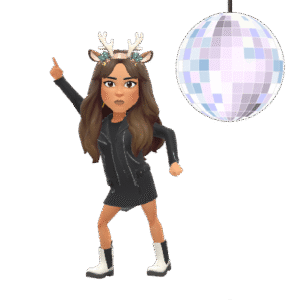
This week, I focused on on something easily overlooked but so important when learning the piano: time signature and rhythm. My goal was to better understand how time signatures affect the way we count, plat music, and start practicing rhythm by clapping alone with the metronome.
Tools that Helped me this Week:
- Metronome Online – a free, simple metronome
- Rhythm Organizer – great for practice
- Rhythm Clap Along – great for beginners/kids clapping rhythms
- Crack the Code: Learn Time Signatures – learning time signatures
- I also tapped our rhythms with my fingers on the table when I didn’t have the piano near buy
What are Time Signatures
Using my educational online platform, “Crack the Code: Learn Time Signatures,” I learned at the beginning of most pieces of music, you’ll see two numbers stacked like a fraction (for example, 4/4 or 3/4). That is the time signature. This tell us how many beats are in a measure and what kind of note gets the best.
Here is my I found:
- 4/4 is called “common time” and means four quarter-note beats per measure. It has this rhythm as most pop songs. (Count – 1-2-3-4)
- 3/4 has three quarter-note beats and gives a waltz-like, swaying rhythm. It has this rhythm in classical music or folk songs. (Count – 1-2-3)
- 2/4 feels like march, a perfect simple strong walking beats. It has this rhythm in dancing music. (Count – 1-2)
- 6/8 this is called “Compound Time”. This means it has technically 6, but grouped as 2 main beats, each split into 3. It has the rhythm of R&B, Irish jigs, and love songs. (Count – 1-la-li, 2-la-li)
- 5/4 has five beats in each measure, and each beat is a quarter note. This rhythm is known as being irregular or an odd meter because most music uses even numbers like 2, 3, or 4 beats per measure. This rhythm is usually used in jazz music. (Count – 1-2-3, 4-5)
- 7/8 means there are seven eight note beats in each measure. This rhythm is also known as being jerky and uneven. This rhythm is also known being in prong rock music as well. (Count – 1-2, 3-4, 5-6-7)
Understanding these time signatures helped me feel more confident when reading music and finding out how to read them.
Clapping with a Metronome
To strengthen my rhythm skills, I used an online metronome and practiced clapping these different rhythms. At first, I kept it simple, clapping quarter notes at a slow tempo (around 60 bpm), once I felt steady, I tried eighth notes and further challenged myself as I got the hang on it.
What I noticed:
- A metronome is super helpful but also challenging. It took me a while to get the hang of counting my beats without counting the metronome. It showed me where I rush or slow down.
- Clapping the rhythm before playing helped me internalize the rhythm before touching the keys.
- I started “feeling” the beat more than just counting it–like dancing with sound.
I additionally used this Youtube video to guide me on clapping beats. It was super easy to use and It honestly made me feel like I knew what I was doing.
Here is a quick video of me trying out these clapping rhythms for the first time!
Goal Reflection
This week I was able to complete my goal successfully. I explored different time signatures, learned to count them, and practiced clapping along with a metronome. It was a big of a challenge as did harder time signatures that went faster than expected. However, practice makes perfect and redid my rhythm claps until I was on the right track. I found that all my online digital tools this week were easy to use especially for beginners like myself. The tool I found the most helpful this week was the Youtube video called, “Rhythm Clap Along- Level 1 to 3”. It provided my with notes I learned last week into a measure. I was provided with different time measures to practice clapping. What I loved about this video was it would clap the beats first for me to listen than it would do it with me. I highly recommend this video for any future teachers in music or future piano learners.
Next Week
Next week, I’m shifting my focus from rhythm to ear training–learning to recognize sounds in music without looking at my sheet music. I’m excited (and a little nervous) to try this kind of musical training because it’s new for me, but I know it will make me stronger, more well-rounded piano player. See you then!
This week, my goal was to understand note values–learning how long each note is held when playing music. I also wanted to learn how to count them, and how to draw them correctly on a music staff.
Tools
- To help me learn and practice, I used a few different digital platforms
What I learned
On Music4Kids Youtube channel “Learn about Note Values in Music”. I was taught this basic information:
- What is a Note Value?
- A note value indicates the length of a note. Meaning how long you hold the notes for.
- Each note has three parts. The note head, the stem, and the flag. Each of these parts can tell you the note value.
- The first note I learned is the Quarter Note. The note head is filled in, and there is no flag at the top of the stem.
- The note value of a quarter note is 1 beat in a measure
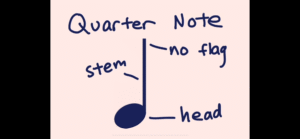

- A Measure is a short phrase in a music piece. The top number of a time signature is, in this case is 4, is how many beats are in a measure. The bottom number, in this case is also 4, tells you the type of note that gets one beat.
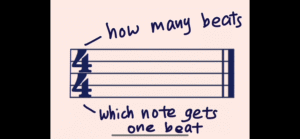
- The Eighth Note looks like a quarter note, however, it has one flag at the top of the stem. Each flag on a stem means it’s half the notes long.
- The note value of it is with the time signature is 1/2 a beat
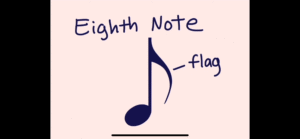
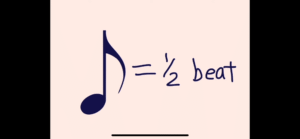
- The note value of it is with the time signature is 1/2 a beat
- The Sixteenth Note with two flags, would be half as long as the eighth note. This can keep going in notes, and the notes can become very short in value.
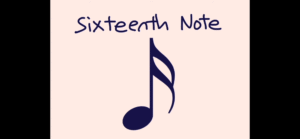
- The Half Note looks like a quarter note, but the note head has space in the middle.
- In the time signature of 4/4 the note value of a half note is 2 beats.
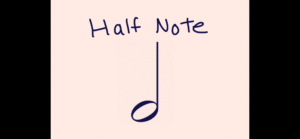
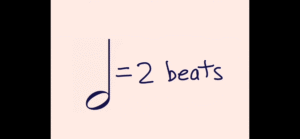
- In the time signature of 4/4 the note value of a half note is 2 beats.
- The Whole Note looks similar to a half note, however, it has no stem.
- In a time signature of 4/4, the note value of a whole note is 4 beats. It takes up the entire measure.
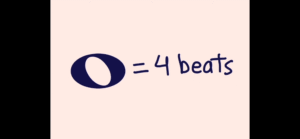

- In a time signature of 4/4, the note value of a whole note is 4 beats. It takes up the entire measure.
I learned that these notes create the rhythm of the song, kind of like a heartbeat of music. Each type of note has a different shape, which helps you know how long to hold it.
To learn/practice writing these note values on a measure. I went onto Pinterest and sound a simple song I could practice drawing. In this case I practiced Mary Had a Little Lamb written by Gilbert DeBenedetti.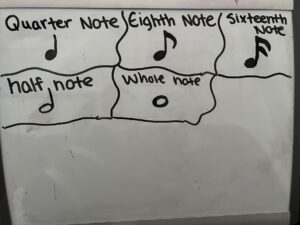
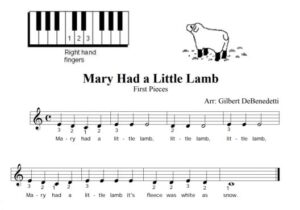

What helped me understand their shapes better was practicing this technique:
- Whole notes are just open ovals with no stem
- Half notes are open ovals with a stem
- Quarter notes are filled-in ovals with a stem
Reflection:
This week helped me better understand how rhythm works in music. I used to think all notes were just symbols, but now I know that each one tells me how long to play a sound. Using these free beginner friendly tools online made this easier to learn at my own pace. I still need more practice counting out loud and drawing from my memory, but I’m proud of how far I’ve come in a few weeks. If anyone is wanting to learn note values I suggest my tools provided above. I watched a couple other videos that were not making much sense, Music4Kids Youtube channel is an awesome channel that is great for all ages that helped me understand in a simple manner. Pinterest also has hundreds of easy sheet music to practice off. Not only for sheet music, but for almost anything you want to learn on the interest.
Next Week:
Next week, I want to explore time signatures and how they affect the way we count music. I also hope to try clapping rhythms along with a metronome to build my timing. I would love any suggestions of any platforms if you have benefited from any in your past learning journeys!
Thank you for following along!
My goal this week, I focused on something that once felt like a foreign language to me: reading music notes. At first glance, the staff, lines, spaces, and note names were overwhelming–but once I started breaking it down step by step, it all began to make sense.
Tools I used
For this week, I explored watching lessons on a YouTube channel and used an app to practice placing notes on a staff. After working with the digital video explanation I used an app to practice identifying notes on the music staff and matching them to the correct piano keys. This helped me start recognizing where each note belongs both visually and on the keyboard. The tools I used were:
What I Learned
In this above video, the Youtuber Pianote taught me many valuable lessons on how to read notes and what each individually means. Through this video I learned:
The Staff:
- Music is written on 5 lines called a grand staff. At the beginning of a grand staff you will either see a treble clef, which is a swirly note, this is sometimes known as a G clef as well. Or you may see a note called a bass clef, sometimes known as a F clef. This is called the bass clef because it’s played lower on the piano.
- On a grand staff, music has a five-line staff. It also has 4 spaces between the lines. Notes can either sit on a line or in a space, and their position tells you what note to play.
The Treble Clef (Right Hand):
- The treble clef is often associated with the right hand.
- An easy way to identify this is a treble clef is because the line that runs through the centre treble clefs curl is the note G, aligned with line 2. When we want to identify the following notes. In my last week’s learning I learned the note are A, B, C, D, E, F, G. This means, after the G note on the second line, the next note is in the space which is A. This continues through the piano alphabet through the following notes through the line and spaces.
- Notes don’t only go up the grand scale, but they can go down the scale too! However, you need to create Ledger Lines.

Source: Pinterest. Musical Notes 101. https://ca.pinterest.com/pin/3307399696884899/
The Bass Clef Notes (Left Hand):
- The bass clef is often associated with the left hand
- The bass clef is instead using the lines starting at G-B-D-F-A and the spaces are A-C-E-G
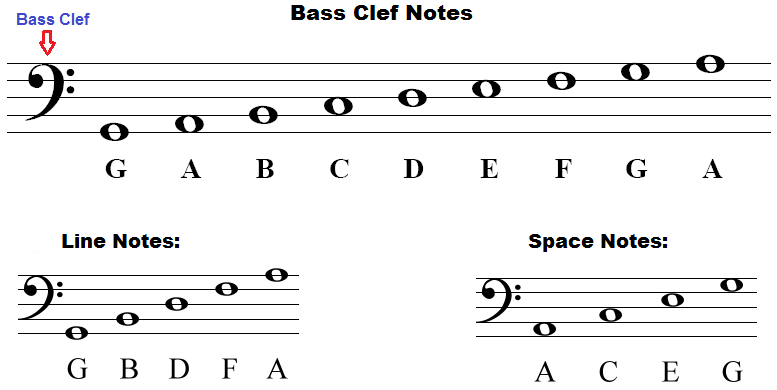
Source: Piano Keyboard Guide. https://www.piano-keyboard-guide.com/bass-clef.html
Ledger Lines:
- Notes above or below the staff use small lines (kind of like floating platforms) to keep the music readable.
Middle C:
- This is the bridge between the treble and bass clefs–it’s now my home base!
TIPS!:
- A great tip she gave to remember the treble clef notes is practicing remembering the saying Every Good Boy Deserves Fudge, which is how to remember the lines for E-G-B-D-F. As well for the spaces to remember the saying for the notes, F-A-C-E.
- A great tip she gave to remember the bass clef notes is practicing remembering the saying, Good Boys Deserve Fudge Always, which is G-B-D-F-A. As well for the spaces to remember the saying for the notes, All Cows Eat Grass, for the notes A-C-E-G.
On the App Notevision I practiced identifying what the notes on the grand scale are and the sounds they make. What I love about this app is it provides real time feedback of how I am doing in my process. For example, In the video I provided I messed up a couple of times. The app stopped me and let me try again before I could continue on. Having this feedback actually helped me recognize every time I messed up, what these key notes were. As I did this practice over and over again, I eventually got the hang of where the notes are. What I also love about this app is theres different ways to practice learning these notes. The app provides lessons on the treble clef with small range of note hints and keyboard notes, this is what I show in the video. It can even show the same note range with no visual aids. This is shown in the second video. What is also super cool about this app is it shows how fast you go when practicing. You could practice over and over again until you beat your score. There is many other cool features on this app such as learning keyboard lesson basics, bass lessons, and grand staff lessons. You can also practice songs, free play, and create your own custom music! I would recommend this for all first time learners when getting to know your notes on a grand staff!
(videos are screen recorded from my iPhone)
My Reflection
This week really boosted my confidence in understanding the language of music. At first, looking at all the lines and symbols on the staff felt confusing, but breaking it down into simple parts—like learning about the grand staff, treble clef, and note patterns—made it feel much more manageable.
Using educational technology tools, such as a YouTube video from Pianote’s page, was super helpful. The instructor explained everything clearly and simply, which made it easy for me to understand.
The most helpful tool this week, however, was the NoteVision app. I liked how it gave me immediate feedback and became more challenging as I improved. The only downside is that it focuses more on memorization than deeper understanding. If you’re someone like me who learns better through explanations or visual patterns, this app might feel a bit limited unless it’s used alongside other learning tools or videos.
Overall, I still have a lot of practice, but I’m proud of how much I’ve learned and I’m excited to keep building on these skills next week!
NEXT WEEK GOALS: Learning note values, how to count them, and how to draw them on a music staff
This week I focused on the absolute basics of the piano, learning the names of the white keys, finding Middle C, understanding finger names, and a easy song with 4 notes. My goal this week was to get comfortable finding notes quickly and using proper hand positioning to prepare for playing simple songs.
Main Resources Used This Week:
This Weeks’s Process:
This week I decided to use my tech tool for my weekly blog post called Flowkey. This website/app provided a simple easy to use introduction to the piano. Through this I learned:
- To start by proper posture. When sitting at a piano, you should be sitting up in an upfront comfortable position. Your fingers should be parallel to the keys when you place your hand in middle of the piano. Your elbows should be pointed slightly outward. When you move your arms outward, your elbows can work together with them so your arms can open up.
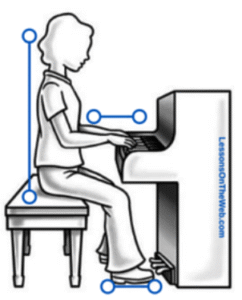
Source: Lessons on The Web. Does Posture Make a Difference in Your Piano Playing. https://www.pianolessonsontheweb.com/blog/does-posture-make-a-difference-in-your-piano-playing
- It gave me a great tip on hand posture. When I first tried playing I noticed I would play notes with my hand slightly straight. Flowkey taught me to slightly bend my fingers and hand. Pretending to hold a small ball!
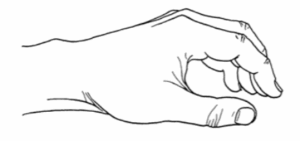
Source: Pdm piano http://www.pdmpiano.org/prelim_p004_1_hand.html
- There is a key called Middle C that is the main starting point when playing. It’s the white key just to the left of the group of two black keys near the middle of the key
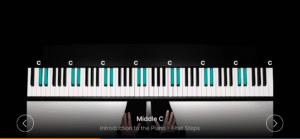
- The white keys are named after the first 7 letters of the alphabet: A, B, C, D, E, F, G. For this process, I first learned C, D, E, F, G.
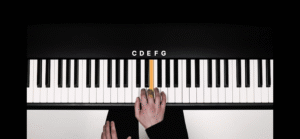
Once I learned these incredible tips on Flowkey. I switched my learning to SimplyPiano. Through SimplyPiano I learned:
- Playing rhythm of the keys I learned to get the hang of how to move my fingers to different keys. On SimplyPiano it asked for me to play the rhythm CC, DD. Than progressively got more challenging, DD, C, DD. My first couple of tries it it took me a while to figure out how to read the written notes while looking at the keys where my C or D was. However, I eventually got the hang of it.
- SimplyPiano encouraged my to try my first song! Say Something written by A Great Big World
This screen recording is SimplyPiano listening to me play. Below is my Piano it is listening to!
Thoughts of Learning Process This Week!
This week I learned a lot about the basics of the Piano! Both apps Flowkey and SimplyPiano has made this week learning the piano way more engaging and accessible. I liked the break down complex concepts into bite-sized, interactive lessons that I can follow at my own pace. It felt as though I was being taught a lesson by an actual teacher. I loved how SimplyPiano gave me instant feedback when I played, helping me correct mistakes right away, while Flowkey offered a more relaxed, visual way to learn songs with real-time guidance and sheet music.
Learning the piano online can work and I encourage for everyone to try! Both educational apps this week made practicing feel less like homework and more like a game – and that’s kept me motivated. Technology has definitely made learning piano from home easier and more fun than I expected.
NEXT WEEKS GOALS: Learning how to read notes and draw them on a staff!
My interest in learning the piano began at a very early age—around 11 or 12 years old. At the time, our new neighbours had just moved in next door, and they had two daughters who were about my age. After school, I would often visit their house and watch them play on a beautiful old piano that had been passed down from their grandparents. Its wooden casing was worn and weathered, having been filled with generations of timeless music. Despite its age, the piano’s soundboard whispered rich, resonant tones that drew me in. I would sit and watch my neighbour for hours as she played songs she had learned in piano class. Her talent inspired me, and I dreamed of becoming just as skilled one day.
As I’ve grown older, my love for the piano has only deepened. For my 16th birthday, I convinced my parents to get me a keyboard piano so I could start learning. I played casually for a while, but as life got busier, I didn’t make time for it and eventually tucked the keyboard away in my closet. Recently, I’ve realized that my love for the arts—whether it’s visual art, dance, or music—was born from those childhood moments. Music has always held a special place in my heart because of the beauty it brings to others.
Now, as a future teacher, I’m inspired to use this learning project as an opportunity to reconnect with music by learning the piano. I also hope to bring my love for music and the arts into the classroom in meaningful ways. I believe these tools can enhance all subject areas and help students manage stress, offering peace and calm through the power of music.
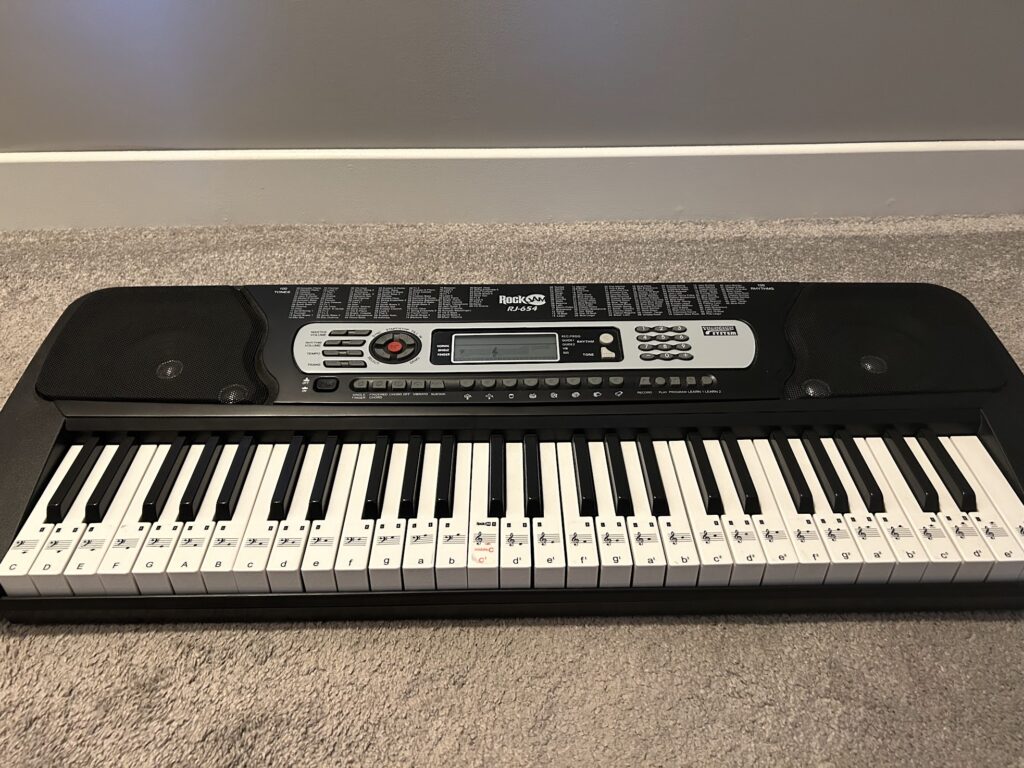
My Learning Goal
My overall goal for this project is to learn the basics of piano and play a simple song by the end of the semester. To achieve this, I plan to:
- Begin by experimenting with the piano keys and familiarizing myself with the sounds they make.
- Learn the layout of the keyboard, identify the pattern of black and white keys, locate Middle C, and memorize the names of the white keys.
- Understand finger numbers and hand positions (assigning numbers 1–5 to each finger) and practice proper posture.
- Learn basic rhythms, starting with whole, half, and quarter notes.
- Begin playing simple songs with one hand—starting with Twinkle-Twinkle Little Star.
- Progress to playing with both hands.
- Start reading easy sheet music, with the eventual goal of learning a popular song to share with others.
- Practice ear training to recognize notes and chords.
Resources I’m Using
To support my learning, I will be using two apps: Simply Piano and Skoove. Both are beginner-friendly and provide real-time feedback by listening to the notes you play. I’ll also be using the website Tone Gym, which offers excellent ear training for beginners. Additionally, I plan to hang a printed diagram of piano keys on my wall to help with memorization throughout the semester. If I discover any new resources along the way, I’ll share them here on the blog.
Getting Started
Currently, I know little to nothing about the Piano or how to play it. I understand that a Piano goes from low notes to high notes. I also understand the Piano notes are A, B, C, D, E, F G, and some areas of these notes have sharp notes and flat notes. However, I am unsure on what this exactly means. In the video below, I share my very first experience experimenting with the piano keyboard—exploring the sounds, identifying where the higher and lower notes appear, and where my A, B, C, D, E, F, G notes appear. In the video below, I share my very first experience experimenting with the piano keyboard—exploring the sounds and identifying where the higher and lower notes appear. Next week, I’ll continue my journey by finding Middle C and learning the keynotes across the keyboard.
Follow along as we learn together on this exciting musical journey!
